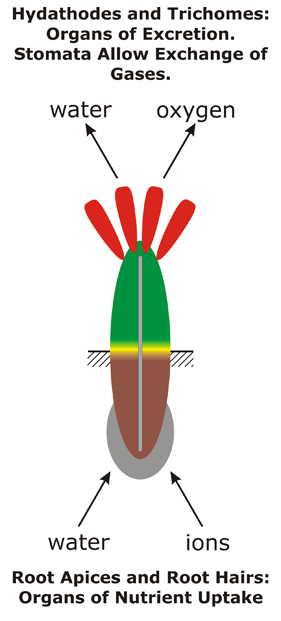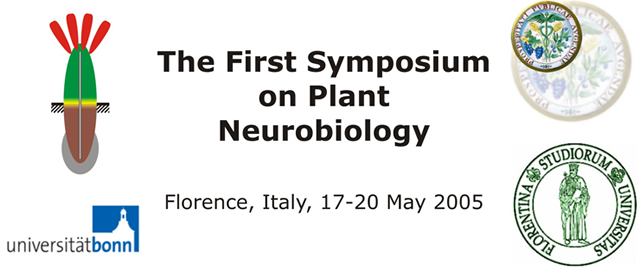- Root Apices represent the Anterior Pole: Specialized for uptake of nutrients and for neuronal activities. Importantly, new roots are formed endogenously (recapitulation of embryogenesis).
- Shoot Apices represent the Posterior Pole: Specialized for photosynthesis (which is dispensable in holoparasitic plants like Rafflesia) and for sexual reproduction. The flower is the perfect form of the shoot. Shoots harbor plant organs of excretion, trichomes and hydathodes. Moreover, stomata allow gas exchange. Similarly as sexual organs, also organs of plant excretion and stomata are located at the posterior part of the plant body. Even more, hydathodes seem to function in analogy to kidney (Pilot et al. 2004, Plant Cell 16: 1827-1840).
- Roots are essential whereas shoots are dispensable: In holoparasitic plants, such as Rafflesia, roots are transformed into haustoria while the green part of the plant is missing completely. Nevertheless, haustoria of Rafflesia form the largest flowers in the plant kingdom which reveals that this unique organism really belongs to plants.
- Auxin: Represents a plant-specific neurotransmitter and is transported, in a light- and gravity-dependent manner, preferentially along the anterior-posterior axis of the plant body. Auxin induces the formation of both vascular strands (plant nerves) and roots (which harbour the “serial plant brain”).
- Roots and Auxin: Root apices represent major sinks for the polar auxin transport. Root apices are extremely sensitive towards externally applied auxin, and lateral root formation is induced by this means. Moreover, auxin rapidly regulates vesicle trafficking and gene expression in roots. Initiation of lateral root primordia is an endogenous process resembling early embryogenesis. In contrast, new shoots and leaves are formed exogenously.
- Plant Synapses: Stable actin-supported adhesive domains (known as end-poles or cross-walls) between adjacent plant cells across which auxin and other chemical signals are transported via actin-based vesicular trafficking pathways. Besides these developmental plant synapses, plants are also capable of forming cell-to-cell junctions with cells of another organisms (plants – fungi – bacteria) corresponding to what is defined as an ‘immunological synapse’. These specialized cell-to-cell adhesion domains involve the plasma membranes of two different organisms opposing each other. Such adhesive domains are also sites of active cell-to-cell transport of molecules and metabolites.
- Vascular Strands: The basic units of the vascular system represent both plant nerves as well as a plant endoskeleton. Leaves contain single strands which combine to form the vascular bundles of the stem, and the vascular cylinder of the root. In roots, the largest portion of the organ is the vascular tissue, and its strands (plant nerves) are supported by numerous cells forming the vascular cylinder.
- Phloem: Supracellular axon-like ‘channel' interconnecting shoot and root apices. Phloem is specialized for transmission of action-potential-driven electric signals. Axon-like means that it is specialized for the rapid transfer of RNA molecules but does not accomplish ribosome assembly and mRNA translation.
- Xylem: Non-living and water-filled tubes specialized for transmission of hydraulic signals which are self-transmitting waves induced and driven by changes in hydrostatic pressure.
- Plant Brain: Each root apex harbours a unit of nervous system of plants. The number of root apices in the plant body is high and all brain-units are interconnected via vascular strands (plant nerves) with their polarly-transported auxin (plant neurotransmitter), to form a serial (parallel) nervous system of plants. The computational and informational capacity of this nervous system based on interconnected parallel units is predicted to be higher than that of the diffuse nervous system of lower animals, or the central nervous system of higher animals/humans.
|
 |


